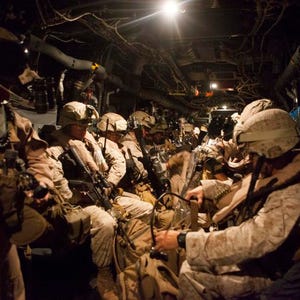U.S. Marines in Europe are training to descend on embassies overrun by terrorists, active shooters or violent rioters as concerns about safety at diplomatic facilities mount following sophisticated attacks on that continent.
Members of the Marine Corps' Spain-based crisis response unit recently spent three days at the U.S. Embassy in Lisbon, Portugal, responding to mock emergencies. The exercises prepared the Marines for real-world missions since their unit could be tapped to rapidly reinforce security at State Department posts across Africa or Europe.
“The ability to do these kinds of missions in an actual embassy is only going to help us further down the line if and when we have to ... go and reinforce [one],” said 1st Lt. John McCombs, a spokesman for the crisis response force.
Responding to emergencies at embassies is one of the crisis response force's main missions. The Marine Corps created the land-based unit about seven months after the 2012 terror attack on a U.S. consulate in Benghazi, Libya, that left four Americans dead.
Within months of the Marines deploying to Spain, the unit was tasked with evacuating State Department personnel from the embassy in South Sudan amid fears that a civil war was about to break out. In July 2014, the task force helped move embassy personnel from Libya to Tunisia when violent clashes between militias broke out in Tripoli.
Embassy reinforcement missions require close interaction with State Department personnel. During the mock attacks at the embassy in Portugal, the crisis response force worked alongside the Marine security guards regularly based there, as well as State Department officials and Portuguese security forces.
That allowed the Marines to troubleshoot how they would integrate with those already on the scene, said 1st Lt. Nicholas Berger, a platoon commander with the crisis response force.
“Moving out to Lisbon allowed us to work through what an embassy reinforcement would actually be like for our company,” said 1st Lt. Nicholas Berger, a platoon commander with the crisis response force. “Our role was to provide security external to the embassy, allowing them to change focus to the inside of the compound.”
Once on the ground, the Marines worked with trainers from the State Department’s diplomatic security service. In one scenario simulating a riot, role-players acting as a mob got increasingly violent, even throwing a Molotov cocktail to test how the Marines responded.
The exercise challenged the Marines to communicate quickly with diplomatic security staff in the midst of a crisis, Berger said. .
“The hardest part was finding ... what they needed from us and how we could help,” he said. “It was really putting myself in the right place, putting my platoon sergeant in the right place [and] talking to the right people.”
The scenarios also challenged infantry Marines to use the right tactics in an embassy setting with limited information about the attack, said Cpl. Zeth Horr, an infantry squad leader.
"We had to be able to take the things that we normally do in a regular or non-permissive environment and shape that to an embassy environment where you had American citizens, local nationals and a whole range of people," he said. "You had to figure out where you fit in and also apply your skills in a different manner than you might be used to."


No comments:
Post a Comment